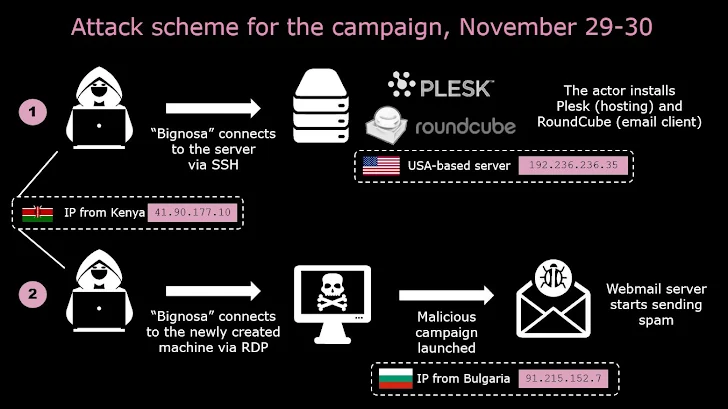That’s where a new phishing campaign against the industry comes in. Disguised as critical vehicle incident reports, this phishing campaign uses a particularly sneaky type of malware to extract sensitive data from unsuspecting employees. By clicking on what would seem to be a harmless link, users are downloading a piece of malware and risking the confidential information of their company. Let’s break down this attack and how to stay safe in the digital Wild West. Let’s check out that scam and how to avoid it.
Table of Contents
ToggleSubscribe to Our Newsletter On Linkedin
Sign up to Stay Tuned with the Latest Cyber Security News and Updates
How does the malware land on your email?
Imagine you receive an email with an urgent subject line, maybe something like “Vehicle Incident Report: Urgent Action Required.” You work in the oil and gas industry, and vehicle safety is a top priority. Naturally, you click to open the email. It mentions a supposed accident and warns of a hefty fine from the Federal Bureau of Transportation (FBT) if you don’t take immediate action. The email helpfully includes a link to a PDF document with more details. It seems legit, right? Wrong!

This is a classic phishing attack, so the link in the email is the bait you’re supposed to click on. Of course, it doesn’t summon a PDF upon clicking—it draws an image, cleverly disguised as a hyperlink. The first click just brings you to a cleverly obscure image; the second click, unseen to you, initializes the download of a ZIP archive on your PC. Inside, the archive is not chock-full of helpful documents but a malware variant: the updated Rhadamanthys.
Rhadamanthys: The Data Thief
Think of Rhadamanthys as a digital burglar. Once in the system, it lays there dormant, waiting for the most opportune time for it to steal your information. This one is out for credentials, login details, and any other form of sensitive information it can lay its hands on. Armed with that information, they could go to all sorts of lengths to play havoc with your organization, ranging from pilfering through files to critical operation disruption.

5 Security Tips for Malware Prevention
- Be Wary of Urgent Emails: Most of the time, phishing emails, which are designed to target you, work because people click as a result of fear or urgency. When an email feels too urgent or critical and needs action right now, take a deep breath and then double-check for authenticity.
- Verify Sender Information: Look at the email address, not just the sender’s name. Does it look like one of the recognized FBT addresses, or does it look like a bunch of letters and numbers tossed together in an email? If in doubt, don’t click!
- Don’t Trust Links Blindly: Hover your mouse over the link in the email. A preview of the true URL should show at the bottom of your browser window. Does this match the text as it appeared in your email? If it goes somewhere sketchy on the web or starts a file download, steer clear.
- Think Before You Click: If you’re in doubt concerning the veracity of an email, get in touch with the sender directly through a known and confirmed phone or email address.
- Report Phishing Attempts: Report phishing attempts by sending any suspicious email to your IT security team. This way, they can trace the phishing campaign and prevent others from being victimized.
Book a Free Demo Call with Our People Security Expert
Enter your details
How Threatcop strengthen the Oil and Gas Industry Security?
The relatively new phishing campaign from Rhadamanthys, related to vehicle incidents, has reinforced the fact that a good security posture is a necessity. Be vigilant, but you do not need to battle this one out alone. Threatcop now provides potent tools to help you reinforce your security stance: Threatcop Security Awareness Training (TSAT) and Threatcop Learning Management System (TLMS).
TSAT: Sharpening Your Workforce’s Security Senses
Think of TSAT as a virtual boot camp for your employees. This advanced program incorporates real-world phishing attacks, walking staff through common threats from the relatively innocuous to the truly dangerous. With TSAT, they will face such simulated threats in the safe environment of our training, learning to recognize warning signs and make decisions accordingly.
TLMS: Continuous Learning for Ongoing Protection
You should follow up your security awareness with continuous learning in an ever-changing threat landscape. Threatcop offers TLMS, a dynamic learning platform that offers continual cyber awareness education. This is a user-friendly system with a very rich resource library, full of interactive modules, quizzes, video tutorials, and much more to keep your employees updated and alert to the latest cyber threats.
The Threatcop Advantage: Security Beyond Basic
You can build a culture of employee awareness by going deep into simulation and persistent learning with TSAT through TLMS. This is how the Threatcop solution empowers the Oil and Gas industry:
- Reduced Risk of Phishing: TSAT’s simulators train your workforce to recognize and avoid phishing attacks like the Rhadamanthys campaign, so the risk of being infected by phishing is greatly reduced.
- Employee Engagement: TLMS becomes attractive for employees through the inclusion of more interactive content.
- Proactive Threat Defense: Make your staff the first line of defense with Threatcop by keeping ahead of developing cyber threats.
See how Threatcop empowered an oil and gas company through TDMARC and TSAT! Read our case study and discover how our comprehensive security awareness solutions can help you build a robust defense against cyberattacks. Contact Threatcop today and take the first step towards a more secure future.

Technical Content Writer at Threatcop
Ritu Yadav is a seasoned Technical Content Writer at Threatcop, leveraging her extensive experience as a former journalist with leading media organizations. Her expertise bridges the worlds of in-depth research on cybersecurity, delivering informative and engaging content.
Technical Content Writer at Threatcop Ritu Yadav is a seasoned Technical Content Writer at Threatcop, leveraging her extensive experience as a former journalist with leading media organizations. Her expertise bridges the worlds of in-depth research on cybersecurity, delivering informative and engaging content.
